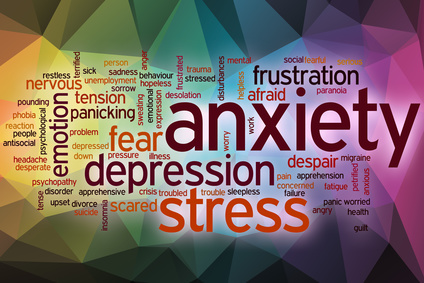Anxiety presents in many different forms and it can be confusing to sort out what exactly you are coping with. Following are some common anxiety-related disorders with a brief review of what the problem looks like in real life and how it differs from other anxiety disorders. If you think you may have an anxiety disorder, speak with a qualified mental health professional regarding diagnosis and treatment. Anxiety disorders are treatable and you can feel better!
Anxiety Disorders
Generalized Anxiety Disorder.
Worry and anxiety about a variety of topics, events, or activities lasting at least 6 months, that is clearly excessive, and is hard to control may signal a diagnosis of generalized anxiety disorder or GAD. This type of excessive worry can include worrying when there is nothing wrong, or in a way that is outsized compared to the actual risk at hand. It can be a ruminative worry that occurs throughout your day, taking your time, energy and happiness. Sometimes people with GAD will describe knowing that they are worrying too much but also a sense that there is always something that they should be worrying about; to not worry would feel odd or suggest they might be missing something. The worry can be about a variety of topics including, work, home, the health and safety of others, one’s own competence, financial concerns and may include frequent “what if” scenarios (“What if I didn’t complete that work report correctly?” “What if I left my iron on?”). Those with GAD may recognize that they are probably worrying too much but find it extremely difficult to control the anxious worrying. In adults, this diagnosis includes at least 3 of the following symptoms: 1) edginess or restlessness; 2) difficulty concentrating; 3) irritability; 4) Increased muscle aches or soreness; 5) problems with sleep. Therapies, such as Cognitive Behavioral Therapy and Acceptance and Commitment Therapy, as well as medications, can be very helpful treatments for GAD.
Social Anxiety Disorder.
Social anxiety disorder, also sometimes called social phobia, involves anxiety related to social interactions as well as distress about being embarrassed and/or judged by others in some way. In response to social situations the person may experience physical symptoms like rapid heartbeat, sweating, blushing, and trembling in addition to significant worry that they will say or do something that leads to humiliation. This disorder can range in severity from mild to severely disabling (at its worst it can feel impossible to work, leave home, or participate in any social activities, leading to additional despair). Sources of worry can include activities like eating in front of others, meeting new people, speaking to others or in front of others, or using public restrooms—essentially any situation in which the person feels there is the possibility for scrutiny, humiliation, or negative judgment by others. While a task may seem simple, such as saying one’s name in a meeting, the possibility of embarrassment can feel agonizing and lead to avoidance of such situations. Such avoidance is often a relieving but temporary fix that can lead to isolation and loss (e.g. a goal to graduate from college can be lost through social anxiety). The good news is that there are effective treatments to help individuals with social anxiety feel better and live a confident and rewarding life.
Panic Attack.
Panic attacks are not, in and of themselves, a mental disorder. While panic attacks can be frightening initially, once physical concerns have been ruled out, if the person having the attack is able to process it as "just a panic attack," it is possible to not be particularly bothered by them. If that's the case, no mental health diagnosis would be given. However, panic attacks often occur as part of other mental disorders, primarily within the anxiety disorders. And when the panic attacks create distress, worry, and negative behavior changes, then panic disorder needs to be considered as a diagnosis(see below). In regard to defining a panic attack, such attacks include sudden intense fear or discomfort that peaks within minutes and during which the person experiences at least 4 of the following symptoms:
Pounding heart
Sweating
Trembling/shaking
Shortness of breath/smothering feelings
Choking feelings
Chest pain/discomfort
Nausea or stomach upset
Feeling dizzy/faint/unsteady
Chills or heat surges
Numbness/tingling
Feeling detached from oneself or like “this isn’t real”
Fear of losing control or “going crazy”
Fear of dying.
This surge of fear can be “out of the blue” without any apparent reason (including during sleep—this is called a “nocturnal panic attack” in which the person awakens from sleep in a panic attack), or may be in response to a certain trigger (e.g., having to give a speech, seeing a spider, hearing a loud noise).
Panic Disorder.
Panic Disorder is diagnosed when an individual has recurrent and unexpected panic attacks (see above) and subsequently has experienced at least one month of persistent worry about having another panic attack or about the consequences of the attack (e.g., “what if I’m really going to have a heart attack?”) OR they show significant negative behavior changes in response to the attack(s) (e.g., they won’t leave the house due to fear of another attack, or stopped exercising due to fear of an attack). To meet criteria for panic disorder, the panic attacks cannot be due to substance use or withdrawal, medical conditions, or other psychiatric concerns. (So, if you have panic attacks related to social situations and meet criteria for social anxiety you would not also receive a diagnosis of panic disorder.)
Specific Phobia.
A specific phobia involves a persistent fear of an object, place or situation that is outsized considering the threat or danger posed. Fear of spiders, flying, blood, and heights are common phobias. A person with a phobia realizes that their fears are out of proportion to the danger present but will go to great lengths to avoid what is causing their fear (e.g., someone with a phobia of flying will find alternate means of travel regardless of time, inconvenience, and expense of doing so). If the phobic item or situation is encountered, there will be a strong anxious response, possibly including a panic attack.
For diagnosis, the fear and distress must be strong enough to result in interference with social and/or work life, and/or the individual feels very upset about having this fear. An example of work interference might be turning down a job you really want due to a fear of heights—and the job is on the 87th floor of a high-rise. (Social phobia, involving fear of social situations, is a separate disorder.) Note that to be a phobia, the fear has to be disproportionate to the situation, to the point that the fear is irrational—for example, having a fear of snakes so severe that it is hard to take your child to the park, even though you live in an area where snakes have never been spotted. Finally, the duration of the phobia has to be at least 6 months to meet diagnostic criteria. A person can be coping with one specific phobia or several specific phobias. Cognitive Behavioral Therapy (CBT) can be helpful in treating phobias.
Substance/Medication-Induced Anxiety Disorder.
I am including this here to encourage readers to consider factors such as caffeine use (whether in coffee, tea or soda drinks), alcohol use, drug use (e.g. cocaine, marijuana, stimulants), and prescribed medication use as prime suspects in the onset of anxiety symptoms or panic attacks where, prior to the use of the substance, there hasn’t been a history or factors that would seem to predict onset of anxiety/panic. Those trying to stay awake (college students and others on deadlines for work) are prime candidates for caffeine overuse that can produce symptoms that mimic anxiety. If this sounds like a possibility, talk to your doctor about your situation and, if relevant, how to best and safely withdraw from the substance.
If you would like to schedule an appointment with Dr. Jana Drew, please call her at 512-960-5265 or contact her here. Dr. Drew provides free 30-minute consultations and would welcome the opportunity to work with you.



